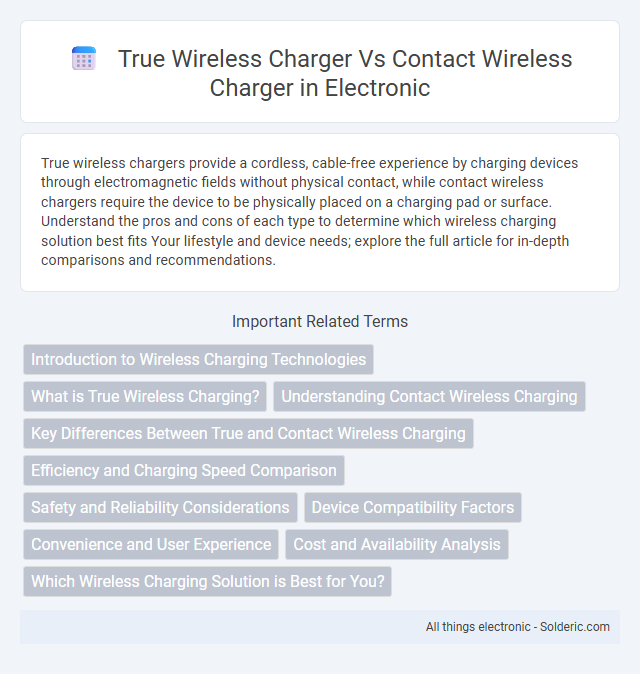True wireless chargers provide a cordless, cable-free experience by charging devices through electromagnetic fields without physical contact, while contact wireless chargers require the device to be physically placed on a charging pad or surface. Understand the pros and cons of each type to determine which wireless charging solution best fits Your lifestyle and device needs; explore the full article for in-depth comparisons and recommendations.
Comparison Table
| Feature | True Wireless Charger | Contact Wireless Charger |
|---|---|---|
| Charging Method | Wireless energy transfer without physical connectors | Wireless charging requiring direct physical contact |
| Device Placement | Flexible placement within charging area | Precise alignment needed for charging |
| Charging Speed | Generally slower due to distance and interference | Faster due to direct contact and efficient energy transfer |
| Compatibility | Supports devices within charging range, multiple devices possible | Requires compatible device with charging coil alignment |
| Power Efficiency | Lower efficiency from energy loss over distance | Higher efficiency with minimal energy loss |
| Use Cases | Ideal for multiple devices, convenience in placement | Best for single device, quick charging sessions |
| Cost | Generally higher due to advanced tech | Lower cost due to simpler design |
Introduction to Wireless Charging Technologies
True wireless chargers enable device charging without any physical connectors by using resonant inductive coupling, offering greater freedom of placement and mobility. Contact wireless chargers rely on magnetic induction through direct contact with the charging surface, ensuring efficient energy transfer and faster charging speeds. Both technologies utilize electromagnetic fields, but true wireless charging provides convenience at the cost of charging efficiency.
What is True Wireless Charging?
True wireless charging enables devices to charge without any cables or physical contact by using electromagnetic fields to transfer energy through the air. Unlike contact wireless chargers that require precise alignment on a charging pad, true wireless chargers allow more flexible positioning and movement while powering your device. This technology's convenience eliminates the need for cables, enhancing user experience in everyday charging scenarios.
Understanding Contact Wireless Charging
Contact wireless charging relies on direct physical interface between the device and the charging pad, ensuring precise energy transfer through electromagnetic induction. True wireless chargers, in contrast, eliminate physical contact by using resonant magnetic coupling, enabling charging within a short range without alignment constraints. Understanding contact wireless charging helps appreciate its advantages in energy efficiency and reduced power loss due to minimal air gap interference.
Key Differences Between True and Contact Wireless Charging
True wireless chargers offer a completely cable-free charging experience by allowing devices to be charged without any physical connectors, relying on radio waves or magnetic resonance to transfer power over short distances. Contact wireless chargers, also known as inductive chargers, require direct physical alignment between the device's charging coil and the charger pad, utilizing electromagnetic induction for power transfer. Understanding these key differences helps you choose the most convenient and efficient wireless charging solution for your specific device compatibility and usage needs.
Efficiency and Charging Speed Comparison
True wireless chargers use resonant induction technology, offering higher efficiency and faster charging speeds by maintaining a stable power transfer over a short distance. Contact wireless chargers require precise alignment between the charger and device, often resulting in slower charging rates and potential energy loss due to misplacement. Optimizing your setup with a true wireless charger ensures quicker, more consistent power delivery for your devices.
Safety and Reliability Considerations
True wireless chargers offer enhanced safety features such as automatic shut-off and temperature control to prevent overheating, making them a reliable choice for wireless energy transfer. Contact wireless chargers, which require physical alignment of devices, reduce the risk of foreign object interference, thereby improving charging safety and consistency. Both technologies incorporate safeguards like overvoltage protection and short-circuit prevention, but true wireless chargers provide more versatility with secure communication protocols to ensure reliable power delivery.
Device Compatibility Factors
True wireless chargers often support a wide range of devices due to standardized Qi technology, enabling seamless charging for smartphones, earbuds, and smartwatches without connectors. Contact wireless chargers require precise alignment and often specific device compatibility, limiting their use to devices designed for their particular charging pads or pins. Device compatibility factors revolve around charging protocols, coil alignment, and power output standards, influencing the efficiency and usability of each wireless charging type.
Convenience and User Experience
True wireless chargers offer unparalleled convenience by allowing devices to charge without any physical connectors, enhancing portability and simplifying use in various settings. Contact wireless chargers require precise alignment between the charging pad and the device's charging coil, which can sometimes lead to interruptions or slower charging times, affecting the overall user experience. The seamless interaction of true wireless charging minimizes user effort and maximizes accessibility, making it ideal for on-the-go lifestyles.
Cost and Availability Analysis
True wireless chargers generally come at a higher price point due to their complex Bluetooth or Wi-Fi integration and standalone charging capabilities, which also limits their availability mostly to premium electronic retailers. Contact wireless chargers, relying on established Qi standard technology, are more affordable and widely available across various retail channels including online marketplaces and physical stores. Cost-effectiveness and broader distribution make contact wireless chargers a more accessible option for the average consumer seeking basic wireless charging functionality.
Which Wireless Charging Solution is Best for You?
True wireless chargers offer unmatched convenience by enabling device charging without any cables or physical contact, ideal for users valuing portability and clutter-free spaces. Contact wireless chargers, relying on close-range electromagnetic induction, provide faster and more efficient energy transfer, suitable for stationary settings where consistent charging speed is a priority. Selecting the best wireless charging solution depends on balancing the need for mobility against charging efficiency and environmental setup.
True wireless charger vs Contact wireless charger Infographic

 solderic.com
solderic.com